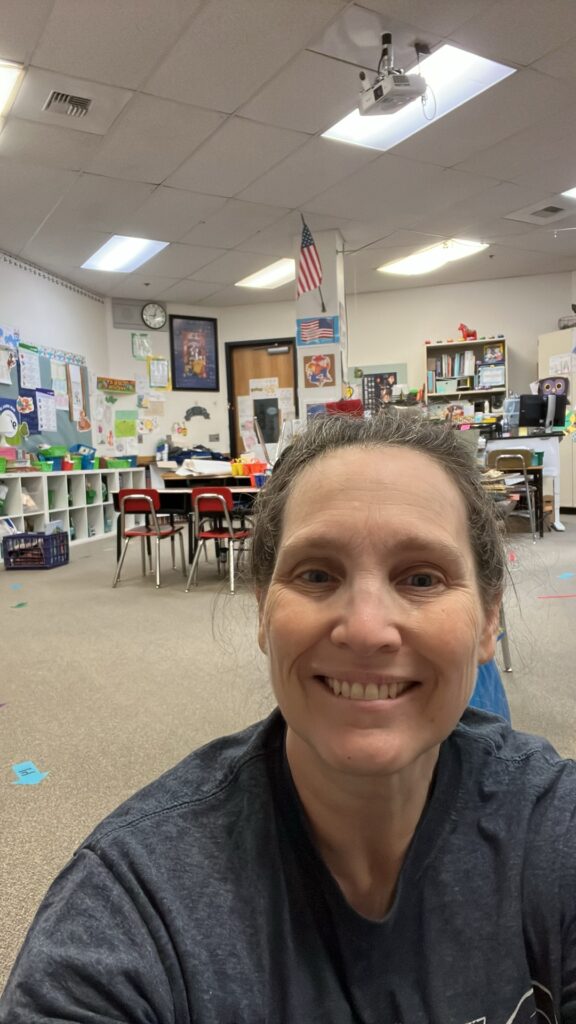Well, I had two, three posts in the last day or so at the end of 2024. Here were are, the first day of 2025. Where was I?

So, there I was, after sleeping in following a lovely quiet evening watching New Year’s Eve celebrations around the world (and eating lovely cookies my spouse surprised me with!), and remembered some very specific things I wanted to accomplish in the classroom today.
I went in first, to move a few lighter-weight (and on wheels!) furniture pieces and start putting materials into newly-cleared spaces. Stidkid #1 and #1 Stiddad arrived a bit later, gamely clearing out a few more spaces so I can easily relocate and re-sort materials, leveling student desks, moving the flag, and organizing games and such. The student desks are still completely covered with my materials (and games and activities!), but there are many empty spots for me to stage our work for the next few months; and the computer cart and materials will be hopefully a little easier to access. I have even managed to create some spaces for students to move away from their desks and work in small groups or independently on the floor.
That, and also!
Yesterday afternoon, a dear friend (C.H.) came to visit, and we made some fun little paper folding fidgets and looked at and talked about “junk journals.” We were going to MAKE a junk journal, but then we just talked and talked…. LOL it was wonderful and fun, and so the next journal the kiddos get for Semester 2 will become a “junk journal” of their own making. It reminded me how much I enjoy being creative with people! I have plans…
I am almost done with my medieval hood, and will reveal it a soon as the hem is complete (and also a mend of some small holes I didn’t notice in the dark fabric until a few days ago).
Our home isn’t “tidy” but it’s comfortable, clean enough, and warm and dry. We have enough room that we can have stidkid #1 (yes, the 32-year old) visiting for more than a month without any of us feeling cramped. When he heads home, it will be a place for stidkid #2 and others to stop in and visit for a day or two here and there.
Our yard isn’t picture perfect, but our gardens are always productive, our trees are (mostly) healthy, and it appears the wildlife are doing okay despite bird flu being very much present in our area. Some mornings I can hear the seals in the inlet. Other times I hear an owl. Or an eagle.
I am okay with imperfect (most of the time). I am still working on knowing when done is better than perfect, when I have spent enough time and need to let go, and neither apologizing for my physical limitations nor using them as an excuse for my current best work not being what it would be (or would have been)…
This year, I am focusing on “keeping things real” – taking time off when I need to so that I can make medical visits, stay healthy, and be available to our family.
This year, I am focusing on “keeping things real” by letting go of materials I will never use, and no one else in our family would want.
This year, I am focusing on “keeping things real” by sometimes making my creating, and writing, and dreaming, a priority.
This year, I am focusing on “keeping things real” by participating in local and state politics in the small ways that I can (since in-person events are out of the question, this will be writing letters and other distance-style campaigns).
This year, I am focusing on “keeping things real” by acknowledging that, as Ashleigh Brilliant wrote: I may not be perfect, but parts of me are excellent.
And finally, I will continue to “keep things real” by teaching, and writing, and to the best of my ability modeling kindness and generosity, determination when times are hard, and bravery when faced with evil. When my heart needs a break from bad news, I will allow myself to rest – and then I will keep going.
Because in the end, “keeping things real” means being honest about what I can, and what I cannot, do – and respecting myself even as I focus on others.

Happy New Year.

